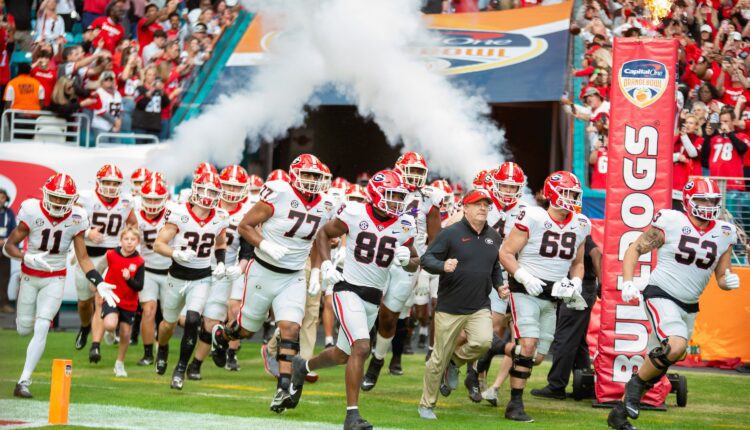
Getty Images
We’re taking the guesswork out of your fantasy football draft. Keep reading to get our free rankings!
Football season is upon us, and with that comes fantasy football drafts. Fantasy football gives us a chance to trash-talk, to bond, and to imagine that we really could be NFL general managers. Just give us the chance!
The first step to building a championship-caliber fantasy football team is, of course, joining a league. If this is your first year trying fantasy football, you can dip your toes in the water with a free public league with strangers on a site like Yahoo. Or, even better, you can use Yahoo or Sleeper or ESPN to start a league with friends or coworkers. These sites do the heavy lifting for newcomers, with preset rules in place.
Once that’s done, it’s time for one of the biggest events of the season: Draft Day. Long-time fantasy players generally consider the Sunday before the start of the NFL season (in this case, September 1) the best day to draft, but pick a day that works for you and your leaguemates.
Figuring out a draft strategy can be a daunting task, but it’s the foundation of your success for the whole year. So we’ve got you covered with a guide on how to perfect your approach by keeping it simple. We’re going to assume some basic understanding of football, but nothing too extreme. You don’t need to know what makes Kyle Shanahan’s West Coast offense different from Sean McVay’s variation of the same scheme or what it means for a team to line up in 11 personnel, but you should know the differences in the fantasy-relevant positions (quarterback, running back, wide receiver, tight end) and what a touchdown looks like.
At the end of this article, we’re going to give you our custom fantasy football rankings, but first, we want to make sure you understand how to use them.
The Basics
Let’s start by acknowledging that every league is going to be a little bit different. For instance, some leagues grant players a point per reception (PPR) – if a player catches a pass, regardless of how many yards that play gets them, they’re guaranteed one point for the week. Other leagues allow you to start two quarterbacks each week, which makes the value of a quarterback much higher.
For our specific player rankings, we’ll assume some of the most common settings:
- 1 starting quarterback
- 2-3 starting running backs
- 2-3 starting wide receivers
- 1-2 starting tight ends
- 0.5 points per reception
- 4 points for passing touchdowns, 6 points for rushing or receiving touchdowns
That said, the drafting principles we’ll cover still apply if your settings look a bit different – just adjust your player rankings as necessary (more on that in a bit).
Now, how does a typical draft work? Each team (a league usually has 8, 10, or 12 teams) is randomly assigned a draft position, and the draft proceeds in a snake-like fashion so that the person who drafts last in the first round will draft first in the second round. So you might be excited to get the first overall pick of the draft, but just be warned that you’ll find yourself waiting until the very end of the next round before you get to pick again – and that wait can be excruciating.
There’s no real ideal draft spot, though anecdotally, the first two picks have felt the most uncomfortable this year. Whatever draft spot you pick from, though, these principles should carry you through.
Principle 1: For the first five rounds (or so), draft the best player available. Full stop.
If you do much draft strategy research, you’ll hear about a lot of approaches: Zero RB, Hero RB, Zero WR, and plenty more. The problem with these approaches is that they predetermine what position you’re going to take in a given round without any of the context of what your leaguemates are doing. Each fantasy football draft is a living, breathing, unique organism. If you find yourself with the eighth pick of the first round and are determined to take a running back no matter what, you might find that the two or three best backs are already gone, and then you’ll be reaching for a lesser running back just to fulfill that preconceived idea.
Instead, we want you to focus on just taking the best player available. If that’s a running back, great! If it’s a quarterback or wide receiver or tight end, that’s also great! Maybe you come out of those first five rounds with four running backs (a scenario we’ll bring to life in a bit). That just means you won’t need to draft as much depth at the position, and can go heavy on receivers in the later rounds.
The more likely case, though, is that you’ll come out of those first five rounds with a pretty balanced start to your roster.
The first tab of the rankings spreadsheet we’ll share at the end of this article is dedicated to the top 50 players, regardless of position. You shouldn’t switch to another tab until all of those guys have been drafted.
Principle 2: Build a balanced roster.
Ultimately, if you have a 15-player roster (and your settings are similar to what we discussed earlier), you’re going to want your team to look something like this:
- 1-2 quarterbacks
- 1-2 tight ends
- 3-5 running backs
- 4-6 wide receivers
- 1 kicker
- 1 defense
If you take one of the quarterbacks from the Top 50 tab of our rankings sheet, you shouldn’t bother to draft a second quarterback later on. As long as your starter is healthy, you’ll only be playing the backup during his one bye week of the season. You’re better off picking up a free agent QB when the need arises than wasting a roster spot with someone who doesn’t have much chance of cracking your starting lineup. In most leagues, there will be plenty of serviceable quarterbacks available on the waiver wire. The exact same goes for tight ends.
Once those top 50 players are gone, it’s time to start looking at individual position tabs on our rankings sheet. This is where you want to start factoring in positional need. Ask yourself, What position do I still need the most of? For instance, if you came out of those first five rounds with three wide receivers, you might only need one more – three more at most. But you’ll still need at least two more running backs, probably three or four, or even five if your other two early picks were for quarterback and tight end.
But our positional tabs are also broken into tiers. Unless you are fully stacked at wide receiver, do not reach down for a Tier 3 running back when there’s still a Tier 2 wide receiver available. Positional need is important in this phase, but really just a tie-breaker when there are lots of players at the same tier still available.
There’s another tie-breaker within each tier, as well. Those top 50 players are all projected to offer you both a safe weekly floor as well as the potential to have some league-winning performances. The players lower down, though, generally offer only one or the other. So we divide them into two categories: “safe” and “upside.” It’s good to have a mix of the two.
That element becomes more important the further in the draft you go. By the time you hit Round 10, you should be able to look at a group of running backs within a tier and take the highest ranked one with the corresponding label that you have the least of. So if you’ve wound up with a bunch of safe players, now is the time to take a chance on an upside player.
This is especially important for quarterbacks and tight ends if you didn’t take one in the first five rounds. Take one that’s safe, and one with upside. You can confidently start the safe option every week until the upside option has a breakout.
We know that this is the principle that can seem the most complicated. When in doubt, just pick a player from the highest tier remaining. But putting in the effort to strike the right balance will pay dividends down the line.
Principle 3: Think (but don’t overthink) about stacks and handcuffs.
If you’ve ever played fantasy football before, you know the pain of losing a star running back to injury. This is where the idea of a fantasy “handcuff” comes into play. A handcuff is a backup running back who, on his own, might not be valuable. But if the player ahead of him on the NFL depth chart gets hurt, his value skyrockets.
So when you draft a running back in those first five rounds, it’s worth locating their backup and moving him up to the top of the next tier. We don’t want to go overboard and reach too far for these handcuffs – it’s not the end of the world if you don’t get them – but it’s a nice fail-safe.
For instance, if you took Bijan Robinson in the first round, you’d want to move his backup, Tyler Allgeier, from Tier 4 to the very top of Tier 3. And while you’re at it, go ahead and switch his label from “upside” to “safe.” For everyone else in the league, Allgeier would be an upside player because his value kicks in with a Robinson injury; for you, though, he’s just an insurance policy.
A similar idea is the fantasy “stack.” If Dak Prescott throws a touchdown pass, that’s a four-point play. If CeeDee Lamb catches a touchdown pass, that’s a six-point play. But if you own both of those players and Prescott connects with Lamb for a touchdown, that’s a ten-point play. So if you take Lamb in the first round, it’s worth moving Prescott from Tier 2 to the top of Tier 1.
Again, you don’t want to reach too hard for these stacks, but give them a little nudge. When you draft a wide receiver, bump up their quarterback; and when you draft a quarterback, bump up their wide receivers and tight ends.
Now, in the case of both handcuffs and stacks, you want to be especially careful when the people you’re bumping are on that Top 50 list, before things are broken into tiers. In that case, we recommend only moving them up one spot. Any more than that, and you’re at risk of missing out on some great players.
Principle 4: Don’t draft a defense or kicker until the last two rounds of your draft.
Seriously. Don’t do it.
Unless you’re in a league of pros, your leaguemates will definitely draft Justin Tucker and the 49ers defense around Round 10. Let them. The difference between the top five kickers and the next five or ten is marginal for fantasy football, and fantasy defenses are extremely volatile. While the competition is taking kickers and defenses, you can collect higher-value players.
Principle 5: Don’t forget to have fun.
Cheesy, right? But it needs to be said. There will come a point in every draft where you’ve got your eye on a particular player. Let’s say Brock Bowers, the rookie tight end for the Raiders. He seems like he’s sliding. Your leaguemates are ignoring him. You’re one pick away. Your heart is pounding. And then, with the pick right before you, someone takes Bowers. The heartache! The agony!
Don’t let it get to you. Just accept that as part of the game and, yes, a part of the fun. If everyone you wanted was right there waiting for you every round, the draft would be pretty boring.
So try not to take it too seriously!
Putting it all together
Now that you know how to use it, you can find our official rankings Google Sheet here. In the top left-hand corner, click “File,” then “Make a copy” to generate a version that is all your own, which you can edit how you see fit and delete players as they come off the board in your live draft.
Let’s go ahead and address the elephant in the room: Many sites rank Christian McCaffrey as the top overall player. We’ve got four players ahead of him. Historically, the kind of season McCaffrey had last year just isn’t repeatable, and he’s already dealing with a calf strain. He’s still a fantastic pick, and if you think we’re crazy, go ahead and bump him up on your copy.
We put this system to the test with a mock draft on Sleeper (you know, for work-related research). Here’s the team we ended up with, picking from the #6 spot in a 10-team draft.
QUARTERBACKS:
- Jordan Love (Round 8)
- Kirk Cousins (Round 11)
RUNNING BACKS:
- Bijan Robinson (Round 1)
- Jonathan Taylor (Round 2)
- James Cook (Round 4)
- Joe Mixon (Round 5)
- Tyler Allgeier (Round 13)
WIDE RECEIVERS:
- Chris Olave (Round 3)
- Diontae Johnson (Round 7)
- Christian Watson (Round 9)
- Marquise “Hollywood” Brown (Round 10)
- Curtis Samuel (Round 12)
TIGHT END:
- Kyle Pitts (Round 6)
DEFENSE:
- San Francisco 49ers (Round 14)
KICKER:
- Cameron Dicker (Round 15)
We accomplished all the core principles with this approach. We didn’t panic when the board started to leave us with lots of running backs in the early rounds. We stayed the course.
Because Kyle Pitts is a top-50 player by our rankings, we didn’t bother drafting a backup tight end. When Pitts has his bye week, we can find someone on the waiver wire. On the other hand, we didn’t get a top-50 player at quarterback, so we doubled up at the position with one safe option (Kirk Cousins) and one option with lots of upside (Jordan Love).
We found a nice balance in late-round wide receivers: Diontae Johnson and Curtis Samuel are both high-floor choices, while Christian Watson and Hollywood Brown offer high ceilings.
Plus, we managed to score not one but two quarterback-receiver stacks in Cousins-Pitts and Love-Watson, and we brought in a handcuff for our first round pick Bijan Robinson with his backup Tyler Allgeier.
And did you notice the defense we ended up with? That’s because Sleeper’s AI drafters know better than to take defenses and kickers before Round 14. Some of your human opponents won’t know any better, and your team will benefit from that.
That’s it. You’re officially ready to dominate your fantasy football draft. Happy drafting!

What to know about the 8 bowl games happening in Florida this winter
Here’s what you need to know about the eight bowl games happening in Florida this winter, from memorable moments to 2024 ticket information. If you...

Adriana Díaz set to shine: Puerto Rican star competes in 2024 WTT finals in Japan
Díaz is one of only three non-Asian players in the women’s singles competition at the WTT Finals. Puerto Rican table tennis star Adriana Díaz...

5 places in Florida to donate clothes, shoes, and more
Decluttering your home can provide such a satisfying feeling of accomplishment. After sorting through all of your belongings and determining what...

8 Orlando hotels that pack as much fun as the theme parks
With waterslides, family arcades, playgrounds for the kids, and spas for mom and dad, these Orlando hotels will make your vacation unforgettable!...



